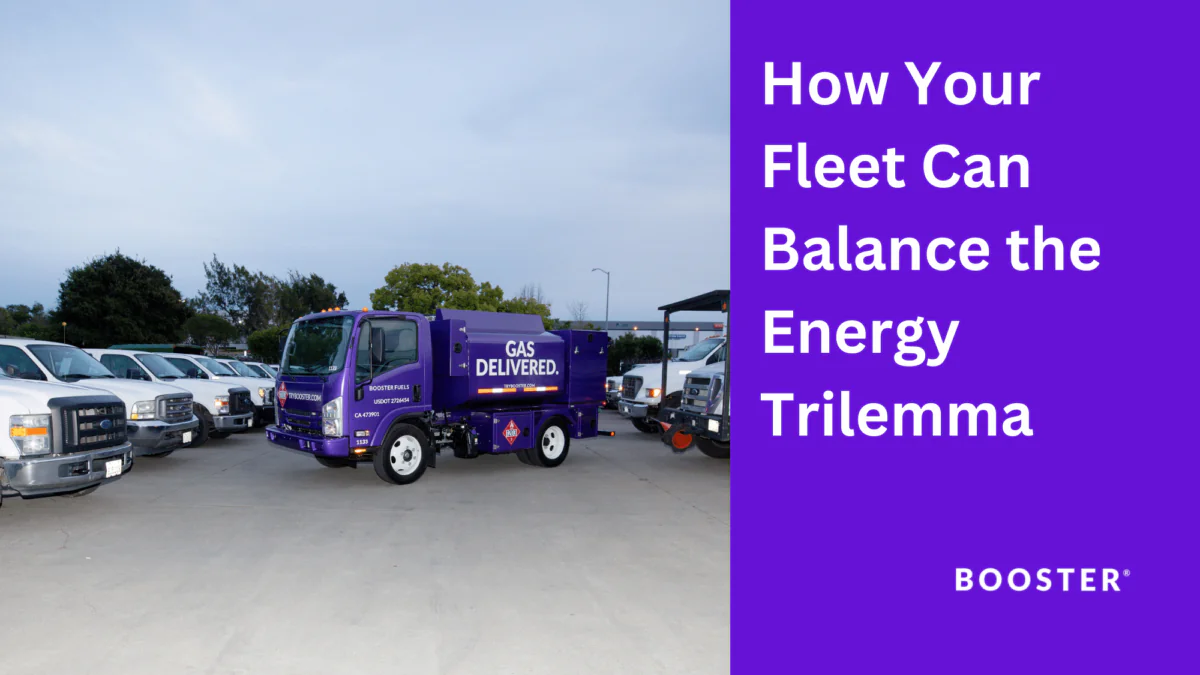As fleet managers stare down the energy transition, the various factors at play can seem overwhelming. Over the next several decades, they’ll need to balance upfront costs associated with transitioning to alternative fuel vehicles, chronic lack of clean energy transportation infrastructure, range anxiety, new maintenance and repair protocols and more.
To complicate matters further, they’ll need to structure their new solutions and protocols carefully, ensuring they support the success of fleets that abate each pillar of the energy trilemma.
What is the energy trilemma?
The energy trilemma refers to the challenge of balancing the interdependent needs of energy security, environmental sustainability, and affordability. These three priorities often conflict with one another, making it difficult to strike the appropriate combination. For example, securing energy supply in the current market may require fossil fuels, which puts environmental sustainability goals at risk.
It is important to consider each pillar in isolation as well as in tandem with the others to build equity and longevity into our changing energy models. As the U.S. continues to pursue the clean energy transition, policy, market structures, infrastructure development, and capital investment must all be made with the balance of the energy trilemma in mind.
How does the energy trilemma affect fleets?
Because the transportation sector consumes significant energy and contributes nearly a third of all U.S. greenhouse gas emissions, fleet operators are pressured to adopt sustainable fueling practices. Whether swapping for sustainable fuels or transitioning to electric vehicles, each fleet’s unique energy transition will require careful consideration of the trilemma’s pillars.
A small fleet relying primarily on diesel, for example, may lack the upfront capital investment capacity to adopt electric vehicles at this time. To make progress toward sustainability while keeping operations affordable, this fleet might be best suited to renewable diesel, which offers up to 85% lower lifecycle emissions than traditional diesel ICE vehicles. But renewable diesel is rarely offered at gas stations, so this fleet may choose to work with a mobile fueler like Booster® to secure a reliable supply of the renewable fuel.
Similar multi-pronged solutions scenarios abound within the transportation sector as fleets find new and creative ways to adapt to the changing market.
How can you balance the energy trilemma with your fleet fueling?
Put simply: the major way fleets meet with the energy trilemma is in fueling and fuel burning. In response, fleets can improve energy efficiency while keeping costs low and maintaining a secure fuel supply by switching to sustainable alternative fuels, using fuel-efficient or zero-emission vehicles, optimizing fuel economy, monitoring and analyzing data, and adopting mobile fuel delivery.
Mobile fuel delivery, in particular, helps fleets balance the complex needs of the energy transition by cushioning a customer-centric service model within a flexible, clean, efficient delivery structure to support fleet sustainability while enhancing overall fleet productivity. Here are the ways mobile fuel delivery responds to each pillar of the energy trilemma:
1. Energy Affordability
Despite widespread desire to make fleets cleaner and greener, the vast majority of fleet managers are constrained first and foremost by budgets. Unfortunately, many new energy sources for fleets are capital-intensive, requiring infrastructure investment or vehicle upgrades, and this is an affordability barrier for many.
Mobile fueling helps by providing cost-effective and convenient fueling solutions to a range of fleet types. By eliminating the need for fleets to travel to and from fixed fueling infrastructure, mobile fueling reduces fueling costs and unproductive labor time. In fact, mobile fueling by Booster offers higher productivity and lower emissions while saving fleets an average of $1600 annually per vehicle.
2. Environmental Sustainability
Mobile fueling helps fleets reduce their environmental impact by enabling the adoption of sustainable fuels. By providing on-site fueling for low- and zero-emissions fuel vehicles, mobile fueling supports the transition to a more sustainable transportation system by enabling easy adoption of clean technologies.
The mobile fuel delivery model also lowers emissions and improves air quality by reducing vehicle miles traveled to fueling stations or infrastructure, which minimizes the fuel burn and associated emissions and environmental impact of fleet operations. Booster’s mobile fuel delivery service reduces fleet emissions by 525 lbs of GHG emissions per vehicle annually, on average.
3. Energy Security
When it comes to adoption of sustainable fleet technologies, access to energy sources and fueling infrastructure presents a major barrier. But security of supply is a crucial element to a successful fleet transition.
Mobile fuel delivery enhances energy security by providing on-site fueling for fleets, reducing the risk of fuel shortages or disruptions. By eliminating a fleet’s reliance on fueling stations or infrastructure, mobile fueling can improve the resiliency and reliability of fleet operations, especially in remote or infrastructure-sparse areas.
Mobile fueling also secures energy supply by enabling access to alternative fuels that may be more secure and resilient than traditional fossil fuels. For example, fleets can use mobile fueling to adopt renewable fuels like renewable diesel, which can be produced domestically from abundant waste feedstocks. Similarly, fleets can use mobile fueling to adopt electric or hydrogen fuel cell vehicles, which can be powered by domestically sourced electricity or hydrogen.
Mobile Fueling for Balanced Fleets
The key to balancing the energy trilemma for fleet fueling lies in resiliency, reliability, and re-imagination of our current fueling systems. Mobile fueling offers the ability to shepherd adoption of sustainable fueling technologies with a reliable, affordable solution. By working with mobile fueling providers, fleets can develop customized fueling plans that meet their specific needs and priorities across their energy transitions while contributing to a more sustainable and secure energy future.
